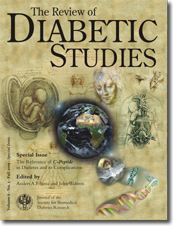Review
| Rev Diabet Stud,
2009,
6(3):180-186 |
DOI 10.1900/RDS.2009.6.180 |
C-Peptide in the Vessel Wall
Daniel Walcher1, Nikolaus Marx2
1Department of Internal Medicine II, Cardiology, University of Ulm, Germany
2Department of Internal Medicine I, Cardiology, University of Aachen, Germany
Address correspondence to: Nikolaus Marx, e-mail: nmarx@ukaachen.de
Manuscript submitted October 9, 2009; resubmitted October 17, 2009; accepted October 27, 2009.
Keywords: diabetes, C-peptide, vascular cell, arteriosclerosis, inflammation, reactive oxygen species, smooth muscle cell, lipoprotein
Abstract
Patients with insulin resistance and early type 2 diabetes exhibit an increased sensitivity to develop a diffuse and extensive pattern of arteriosclerosis leading to a remarkable increase in vascular complications, including myocardial infarction and stroke. The accelerated atherosclerosis in these patients is likely to be multifactorial. In this review, we introduce the new hypothesis that C-peptide could play a role as a mediator of lesion development. Patients with type 2 diabetes show increased levels of the proinsulin cleavage product C-peptide, and in the past few years, various groups have examined the effect of C-peptide in vascular cells as well as its potential role in lesion development. Recent data suggest that C-peptide deposits in the vessel wall could promote the recruitment of monocytes and CD4-positive lymphocytes in early arteriosclerotic lesions. Furthermore, C-peptide induces proliferation of vascular smooth muscle cells, a critical step in atherogenesis and restenosis formation. The present review summarizes this new pathophysiological aspect and discusses the potential relevance for lesion development.
Fulltext:
 HTML
, HTML
,  PDF
(188KB) PDF
(188KB)
This article has been cited by other articles:
|
 C-Peptide in the Vessel Wall (188KB)
C-Peptide in the Vessel Wall (188KB)





